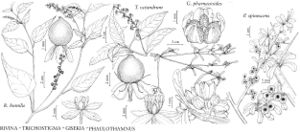Difference between revisions of "Achatocarpaceae"
FNA>Volume Importer |
imported>Volume Importer |
||
| (7 intermediate revisions by 2 users not shown) | |||
| Line 13: | Line 13: | ||
}}<!-- | }}<!-- | ||
| − | --><span class="statement" id="st- | + | --><span class="statement" id="st-undefined" data-properties=""><b>Shrubs </b>or small trees. <b>Branchlets</b> spinescent, sometimes with scattered thorns. <b>Leaves</b> alternate, sometimes fasciculate, exstipulate; blade spatulate to oblanceolate to elliptic, margins entire, venation pinnate. <b>Inflorescences</b> axillary racemes or panicles, or flowers solitary; bracts 0.5–1 mm; bracteoles present or absent. <b>Flowers</b> unisexual, staminate and pistillate on same plant; perianth simple; tepals 4–5, imbricate, distinct, herbaceous. <b>Staminate</b> flowers: stamens [10–]12–14[–20], exserted; filaments filiform, 1–1.5[–2] mm; anthers basifixed, oblong, extrorsely dehiscent. <b>Pistillate</b> flowers: pistils 2-carpellate; ovary 1-locular; style absent; stigmas 2, filiform. <b>Fruits</b> berries. <b>Seed</b> 1, lenticular, without true endosperm; embryo annular, surrounding perisperm.</span><!-- |
-->{{Treatment/Body | -->{{Treatment/Body | ||
|distribution=North America;South America. | |distribution=North America;South America. | ||
|discussion=<p>Genera 2, species 16 (1 genus, 1 species in the flora).</p><!-- | |discussion=<p>Genera 2, species 16 (1 genus, 1 species in the flora).</p><!-- | ||
| − | --><p>Achatocarpaceae has been included in Phytolaccaceae by numerous authors (e.g., G. K. Brown and G. S. Varadarajan 1985). Achatocarpaceae is distinguished from Phytolaccaceae by a combination of characters, chiefly unilocular ovaries with a single ovule, unisexual flowers, berrylike fruits, and pollen with obscure pores. Minute vessel pits, lack of successive cambia, and lack of betalains or anthocyanins are characters further separating Achatocarpaceae from Phytolaccaceae (S. Carlquist 2000). Both genera, Achatocarpus Triana and Phaulothamnus, have the protein type of sieve-tube plastid characteristic of the centrospermous families (J. W. Nowicke and J. J. Skvarla 1979). The similar pollen morphology—spheroidal shape, apertures mostly of 4–6 large, poorly defined pores, and scabrate tectum—also supports the close relationship of Achatocarpus and Phaulothamnus and reinforces the case for separate family status (J. W. Nowicke and J. J. Skvarla 1982).</p> | + | --><p>Achatocarpaceae has been included in Phytolaccaceae by numerous authors (e.g., G. K. Brown and G. S. Varadarajan 1985). Achatocarpaceae is distinguished from Phytolaccaceae by a combination of characters, chiefly unilocular ovaries with a single ovule, unisexual flowers, berrylike fruits, and pollen with obscure pores. Minute vessel pits, lack of successive cambia, and lack of betalains or anthocyanins are characters further separating Achatocarpaceae from Phytolaccaceae (S. Carlquist 2000). Both genera, Achatocarpus Triana and <i>Phaulothamnus</i>, have the protein type of sieve-tube plastid characteristic of the centrospermous families (J. W. Nowicke and J. J. Skvarla 1979). The similar pollen morphology—spheroidal shape, apertures mostly of 4–6 large, poorly defined pores, and scabrate tectum—also supports the close relationship of Achatocarpus and <i>Phaulothamnus</i> and reinforces the case for separate family status (J. W. Nowicke and J. J. Skvarla 1982).</p> |
|tables= | |tables= | ||
|references={{Treatment/Reference | |references={{Treatment/Reference | ||
| Line 50: | Line 50: | ||
|family=Achatocarpaceae | |family=Achatocarpaceae | ||
|illustrator=Barbara Alongi | |illustrator=Barbara Alongi | ||
| + | |illustration copyright=Flora of North America Association | ||
|distribution=North America;South America. | |distribution=North America;South America. | ||
|reference=brown1985a;carlquist2000a;eliasson1993a;heimerl1934b;nowicke1982a | |reference=brown1985a;carlquist2000a;eliasson1993a;heimerl1934b;nowicke1982a | ||
| Line 55: | Line 56: | ||
|publication year= | |publication year= | ||
|special status= | |special status= | ||
| − | |source xml=https:// | + | |source xml=https://bitbucket.org/aafc-mbb/fna-data-curation/src/2e0870ddd59836b60bcf96646a41e87ea5a5943a/coarse_grained_fna_xml/V4/V4_21.xml |
| − | |||
| − | |||
| − | |||
| − | |||
| − | |||
| − | |||
| − | |||
| − | |||
| − | |||
| − | |||
| − | |||
| − | |||
| − | |||
| − | |||
| − | |||
| − | |||
| − | |||
| − | |||
| − | |||
| − | |||
| − | |||
| − | |||
| − | |||
| − | |||
| − | |||
| − | |||
| − | |||
| − | |||
| − | |||
| − | |||
| − | |||
| − | |||
| − | |||
| − | |||
| − | |||
| − | |||
| − | |||
}}<!-- | }}<!-- | ||
-->[[Category:Treatment]] | -->[[Category:Treatment]] | ||
Latest revision as of 21:57, 5 November 2020
Shrubs or small trees. Branchlets spinescent, sometimes with scattered thorns. Leaves alternate, sometimes fasciculate, exstipulate; blade spatulate to oblanceolate to elliptic, margins entire, venation pinnate. Inflorescences axillary racemes or panicles, or flowers solitary; bracts 0.5–1 mm; bracteoles present or absent. Flowers unisexual, staminate and pistillate on same plant; perianth simple; tepals 4–5, imbricate, distinct, herbaceous. Staminate flowers: stamens [10–]12–14[–20], exserted; filaments filiform, 1–1.5[–2] mm; anthers basifixed, oblong, extrorsely dehiscent. Pistillate flowers: pistils 2-carpellate; ovary 1-locular; style absent; stigmas 2, filiform. Fruits berries. Seed 1, lenticular, without true endosperm; embryo annular, surrounding perisperm.
Distribution
North America, South America.
Discussion
Genera 2, species 16 (1 genus, 1 species in the flora).
Achatocarpaceae has been included in Phytolaccaceae by numerous authors (e.g., G. K. Brown and G. S. Varadarajan 1985). Achatocarpaceae is distinguished from Phytolaccaceae by a combination of characters, chiefly unilocular ovaries with a single ovule, unisexual flowers, berrylike fruits, and pollen with obscure pores. Minute vessel pits, lack of successive cambia, and lack of betalains or anthocyanins are characters further separating Achatocarpaceae from Phytolaccaceae (S. Carlquist 2000). Both genera, Achatocarpus Triana and Phaulothamnus, have the protein type of sieve-tube plastid characteristic of the centrospermous families (J. W. Nowicke and J. J. Skvarla 1979). The similar pollen morphology—spheroidal shape, apertures mostly of 4–6 large, poorly defined pores, and scabrate tectum—also supports the close relationship of Achatocarpus and Phaulothamnus and reinforces the case for separate family status (J. W. Nowicke and J. J. Skvarla 1982).
